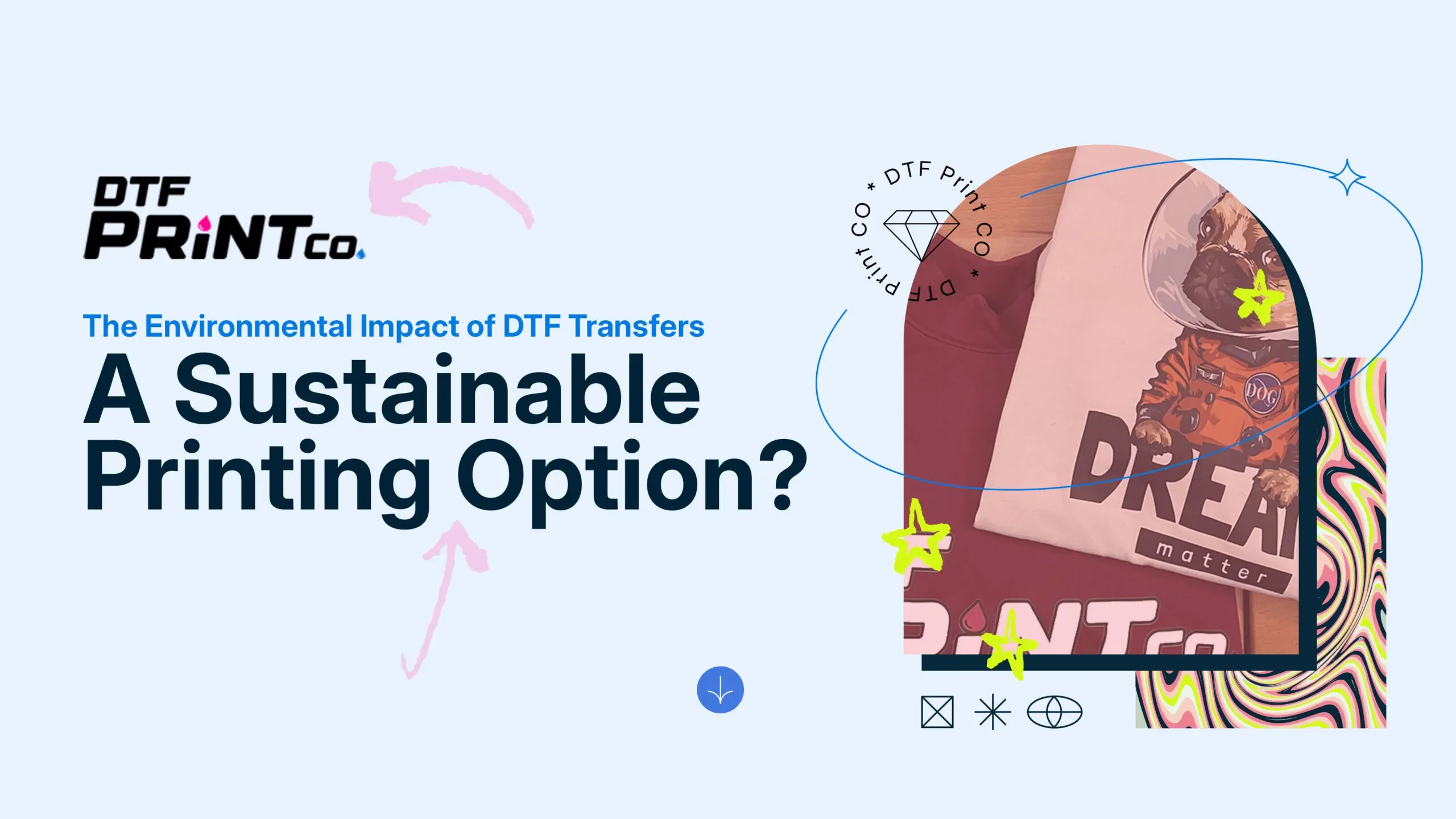The Environmental Impact of DTF Transfers is a pressing topic as the fashion industry gradually shifts toward more sustainable methods. Direct-to-Film (DTF) printing, known for its high-quality outputs and operational efficiency, has gained traction not just for its advantages but also for its potential ecological concerns. While DTF technology relies predominantly on water-based inks, which are less harmful than traditional inks, there are still significant environmental considerations such as waste management and chemical use. Businesses adopting DTF printing must be vigilant about responsible ink disposal and explore eco-friendly printing practices that minimize waste. This exploration into the environmental impact encourages a dialogue on how to balance vibrant, fashionable production with sustainable operations.
Understanding the ecological ramifications of Direct-to-Film transfer processes is increasingly crucial in today’s print-based industries. With innovative designs and vibrant colors becoming the hallmark of modern printing, it is essential to categorize these methods under broader sustainability discussions. As the apparel sector becomes attuned to its carbon footprint, many manufacturers are investigating alternatives like eco-friendly printing practices and energy-efficient technologies. These initiatives not only support waste management in printing but also pave the way for sustainable fashion and responsible consumption habits among consumers. As we delve deeper into these eco-conscious initiatives, the potential for DTF technology to transform into a model of sustainable advancement becomes ever clearer.
Understanding the Environmental Impact of DTF Transfers
The environmental impact of Direct-to-Film (DTF) transfers is a growing concern as the technology becomes more widely adopted within the apparel and printing industry. DTF printing involves the use of water-based inks, which are touted for their lower toxicity compared to solvent-based inks traditionally employed in printing. However, it’s essential to recognize that these water-based inks still carry environmental implications, particularly during their disposal. If not managed properly, even these seemingly harmless inks can release harmful substances into soil and waterways, posing risks to local ecosystems. Manufacturers need to pay attention to not only the ink composition but also its application and after-use management to minimize any adverse environmental impact.
In essence, understanding the environmental implications of DTF printing means looking beyond the surface. While these inks are generally safer, proper waste management practices must be inherent in the production process. Prioritizing eco-friendly printing practices not only helps mitigate immediate risks but also promotes sustainable development in the long run.
Moreover, the impact of DTF printing extends beyond ink usage. The overall waste generated from producing DTF transfers, such as surplus film and used equipment, is a significant contributor to environmental degradation. These materials often end up in landfills if not recycled or properly disposed of, which can lead to long-term environmental consequences. Companies engaged in DTF printing must adopt comprehensive waste management strategies to ensure that their operations contribute to a circular economy. By implementing recycling programs or utilizing biodegradable materials, businesses can effectively reduce their environmental footprint and align their operations with sustainable practices.
The Advantages of DTF Technology for Sustainable Printing
DTF printing boasts several advantages that position it as a potentially sustainable choice within the printing industry. One key benefit of DTF technology is its ability to print on a broad spectrum of fabrics, which reduces the need for multiple setups and processes for different materials. This versatility not only saves time but also decreases energy consumption and associated costs. By leveraging DTF technology, print shops can streamline their operations and minimize their resource usage while still delivering high-quality products that meet consumer demands for personalization and customization.
Moreover, the DTF process generates less waste compared to traditional printing methods, which rely heavily on additional processes and materials, contributing further to sustainability. With advancements in technology, manufacturers can continuously improve efficiency, which aligns with eco-friendly printing practices. The reduction of excess equipment and materials signifies a meaningful step towards achieving sustainable production models that benefit both businesses and the environment.
In addition to operational efficiency, DTF printing integrates well with the use of water-based inks that minimize harmful chemical exposure. Water-based inks are generally less toxic, making them a safer choice for both operators and the environment. They are easier to clean and require less hazardous waste management compared to solvent-based counterparts. As a result, the industry is experiencing a shift towards technologies that not only demonstrate high-quality printing capabilities but also focus on promoting healthier working environments and greater ecological responsibility.
Sustainable Practices in DTF Printing
Sustainable practices in DTF printing encompass various measures aimed at minimizing the environmental impact throughout the production cycle. One of the most effective approaches is the implementation of energy-efficient technologies. By adopting newer, high-performance printers that utilize less energy, businesses can significantly reduce their carbon footprint. Additionally, integrating renewable energy sources, such as solar panels, into production facilities can further enhance sustainability efforts and position companies as leaders in eco-friendly operations.
Furthermore, companies should consider establishing robust recycling programs for leftover materials, such as films and ink cartridges. Developing partnerships with recycling specialists can promote the responsible disposal of these materials, transforming waste into new resources rather than allowing it to contribute to landfill overflow. This cycle supports the principles of a circular economy, encouraging businesses to embrace sustainability in practical and impactful ways.
Another essential practice for sustainable DTF printing is actively pursuing and adopting eco-friendly alternatives in every facet of the operation. This includes sourcing materials from sustainable suppliers that prioritize minimal environmental impact, as well as exploring biodegradable inks and films as substitutes for standard materials. Putting a strong emphasis on sustainability across the supply chain not only reduces the overall ecological footprint but also resonates with increasingly environmentally conscious consumers. By committing to these sustainable methods, businesses can better align their operations with global efforts aimed at nurturing a healthier planet.
Waste Management Strategies for DTF Printing
Waste management strategies are critical in minimizing the environmental impact of DTF printing. Every stage of the printing process can generate waste, from excess films to used ink cartridges, making it vital for companies to adopt comprehensive waste management systems. One effective strategy is to implement a waste audit to evaluate what materials are being wasted and identify areas for improvement. By conducting these assessments, companies can create tailored waste reduction programs that focus on recycling and reuse, significantly lowering landfill contributions.
Additionally, companies can collaborate with local organizations or recycling centers that specialize in handling such materials, ensuring responsible disposal or repurposing. For instance, turning waste into usable products can help underscore a company’s commitment to sustainability, appealing to eco-minded consumers who seek ethical practices from brands.
Aside from operational changes, educating staff about responsible waste management can further enhance the effectiveness of these strategies. By providing training and resources, employees can understand the importance of reducing waste and contribute to operational sustainability. Encouraging a culture of environmental awareness within the workplace maximizes the impact of sustainable practices and emphasizes the collective responsibility of all members of the organization with respect to minimizing environmental harm.
The Role of Water-Based Inks in DTF Printing
Water-based inks play a pivotal role in enhancing the sustainability profile of DTF printing. Unlike traditional solvent-based inks, which contain volatile organic compounds (VOCs) detrimental to air quality and health, water-based inks offer much safer alternatives that lessen the negative environmental footprint. This shift not only supports eco-friendly printing practices but also enhances the safety and well-being of workers in the printing sector. With growing regulations and consumer demand for safer products, the transition to water-based inks illustrates the industry’s commitment to fostering a healthier workplace and ecological responsibility.
Moreover, the compatibility of water-based inks with DTF technology allows for vibrant prints without compromising on quality or durability. This means businesses can achieve remarkable results while adhering to sustainable principles, driving innovation in eco-friendly printing initiatives. As manufacturers invest in research to enhance these inks’ performance and broaden their application, the potential for sustainable practices in DTF printing continues to expand.
Commercial adoption of water-based inks is not without challenges; however, ongoing research and development have yielded results that minimize these barriers. By exploring advancements in ink formulations and mixtures, manufacturers are finding solutions that improve adhesion, washability, and overall performance, ensuring that businesses can rely on water-based inks without sacrificing print quality. As these innovations mature and become more widely available, the use of water-based inks within DTF printing not only enhances sustainability but also aligns with broader industry trends towards reducing environmental impacts.
Frequently Asked Questions
What is the environmental impact of DTF transfers compared to traditional printing methods?
The environmental impact of DTF transfers is generally lower than that of traditional printing methods due to the use of water-based inks which contain fewer harmful chemicals. Additionally, DTF printing can produce less waste and energy consumption through efficient practices, making it a more sustainable choice in the apparel industry.
How do water-based inks in DTF printing contribute to its sustainability?
Water-based inks in DTF printing significantly enhance sustainability as they are less toxic and reduce harmful emissions compared to solvent-based inks. While they may still contain additives, their lower environmental footprint makes them a preferable choice for eco-friendly printing practices.
What measures can be taken for waste management in DTF printing?
Effective waste management in DTF printing includes implementing recycling programs for leftover film and used ink cartridges and adopting biodegradable materials. These practices help minimize landfill contributions and promote a circular economy in the printing sector.
What are the DTF technology advantages in terms of environmental impact?
DTF technology advantages include greater efficiency in ink usage and quicker production times, leading to reduced energy consumption. Moreover, advancements in DTF printing are driving innovation toward more sustainable practices, thus positively impacting the environment.
Are companies implementing sustainability initiatives in DTF transfers?
Yes, many companies are increasingly focused on sustainability initiatives in DTF transfers. This includes developing eco-friendlier inks, establishing recycling programs, and investing in energy-efficient manufacturing technologies to decrease their ecological footprint.
How does energy consumption in DTF printing compare to other printing technologies?
Energy consumption in DTF printing can be lower than in other printing technologies, especially when using newer, more efficient equipment. This efficiency contributes to a reduced environmental impact, making DTF printing a viable option for eco-conscious brands.
| Key Point | Details |
|---|---|
| Ink and Chemical Use | DTF primarily uses water-based inks, which are less harmful than solvent-based inks, yet still contain additives that can pose environmental risks if not managed properly. |
| Waste Generation | DTF printing generates waste, including leftover film and used ink cartridges. Sustainable practices such as recycling and using biodegradable materials are encouraged. |
| Energy Consumption | DTF can be energy-efficient compared to other printing methods. Implementation of energy-saving measures is essential for sustainability. |
| Sustainability Initiatives | Many companies are developing less harmful inks, recycling programs, and investing in energy-efficient technology to minimize environmental impact. |
| Research and Innovations | Ongoing research aims to improve DTF technologies with eco-friendlier inks and closed-loop systems to reduce environmental burdens. |
| Industry Response | Brands adopting sustainable practices in DTF printing are gaining consumer support, as there is a growing demand for environmentally responsible solutions. |
Summary
The Environmental Impact of DTF Transfers is a crucial topic in today’s printing and apparel industries. As DTF printing technology grows in popularity, it is vital to address the various environmental implications that accompany its use. Key concerns include the management of inks, waste generation, energy consumption, and the importance of sustainability initiatives. Many companies are now focusing on eco-friendly practices, such as utilizing water-based inks, implementing recycling programs, and improving energy efficiency. Furthermore, ongoing innovations in DTF technology are aimed at minimizing environmental burdens, which reflects a broader commitment to sustainability in the industry. By actively engaging in these initiatives, the DTF printing sector can move toward a more sustainable future that benefits both businesses and the environment.



